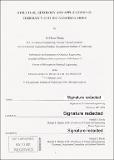Structure, rheology and applications of thermally-gelling nanoemulsions
Author(s)
Cheng, Li-Chiun.
Download1292981652-MIT.pdf (75.46Mb)
Other Contributors
Massachusetts Institute of Technology. Department of Chemical Engineering.
Terms of use
Metadata
Show full item recordAbstract
Colloidal gelation is an effective tool to engineer material properties. Nanoemulsions, liquid-liquid dispersions where the droplet size is on the order of 100 nm, have become an emerging model system for studying aspects of colloidal gel materials. In conventional approaches, the gelation of nanoemulsions relies on the addition of another component into the suspension. However, such strategies require adding or removing components, which can be challenging for material processing, manipulation and studies of the colloidal gel physics. Therefore, a simple external stimulus such as temperature that can induce gelation of the nanoemulsion is highly desired. This thesis focuses on the design and property-structure relationship of novel nanoemulsion dispersions whose gelation is responsive to temperature. Armed with a molecular-scale understanding of the thermally-gelling nanoemulsion system, we design a gelling platform that can accommodate a wide range of colloidal formulations and gelling nanoemulsions that are responsive to different external stimuli such as pH and ionic strength. Moreover, by using the resulting thermally-gelling nanoemulsions, we study fundamental aspects of colloidal gel physics and develop applications for practical use. First, we design a gelling colloidal system whose inter-droplet interaction is modulated through thermally-responsive repulsions. By including amphiphilic oligomers in colloidal suspensions, the ionic surfactants on the colloids are replaced by the nonionic oligomer surfactants at elevated temperatures, leading to a decrease in the electrostatic repulsion. The mechanism is examined by carefully characterizing the colloids, and subsequently allowing the construction of interparticle potentials to capture the material behaviors. With the thermally-triggered surfactant displacement, the dispersion assembles into a macroporous viscoelastic network, and the gelling mechanism is robust over a wide range of compositions, colloid sizes and component chemistries. Second, with the molecular understanding of the thermally-gelling nanoemulsion system, nanoemulsions that are responsive to different stimuli are designed and studied. In one project, we report a gelling nanoemulsion system in which the material properties are responsive to changes in temperature and pH. The nanoemulsion is stabilized using a weak acid surfactant containing a poly(ethylene glycol), PEG, segment and a carboxyl group. We show that the interplay of the dissociated carboxyl group and the PEG segments greatly affects the nanoemulsion properties and gives rise to the thermally and pH-responsive gelation of the system. In the other project, we revisit the original nanoemulsion that the Doyle group designed and investigate the previously-overlooked depletion interactions and screened electrostatic repulsions. We take advantage of these interactions and study the material behaviors by sequentially applying two different gelation routes - first screening the electrostatic repulsion and then inducing the droplet bridging. The results show a non-intuitive trend in the material, and we show that the screening of electrostatic repulsions at room temperature in the first step has a considerable influence on the nanoemulsion microstructures and the associated rheological properties. Third, using thermally-gelling nanoemulsions, we investigate the effect of processing history on the material properties of colloidal gels. We provide new experimental evidence of path-dependent rheology and associated microstructures in colloidal gel systems. Moreover, we also show that material properties can be beyond the limit set by direct quenching and the gel strength can be greatly enhanced. On the other hand, we perform multiple particle tracking (MPT) to probe the nanoemulsion gels at a micrometer scale. We show that, by tailoring the surface chemistry of MPT probe beads, different domains of the gel microstructures are independently probed. The transportation modes of particles and the gel strength at different length scale are obtained. Finally, the complex structure from the self-assembled nanoemulsions is utilized for practical applications. We show that we can synthesize hierarchical hydrogels using 3D-printing. By properly engineering the nanoemulsions, the gel serves as ink with good shear-thinning behavior and remarkable structural recovery. The bottom-up route via droplet self-assembly provides various internal structures, while the top-down route during printing shapes the hydrogel geometry. The resulting hydrogels can be used in applications such as membranes and tissue engineering.
Description
Thesis: Ph. D., Massachusetts Institute of Technology, Department of Chemical Engineering, May, 2020 Cataloged from the official PDF of thesis. Includes bibliographical references (pages 206-227).
Date issued
2020Department
Massachusetts Institute of Technology. Department of Chemical EngineeringPublisher
Massachusetts Institute of Technology
Keywords
Chemical Engineering.